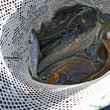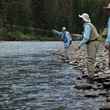I spend a lot of time teaching fly casting, and the double haul frequently arises among students as a topic of discussion and questions. Many of the questions are ones that arise time and again. So, for anglers that might be wondering about the double haul and whether it’s worth incorporating into their fishing, here are some answers.
What is the double haul?
Simply put, it’s an advanced casting technique that increases the speed of the fly line during the cast. To achieve this, the line hand literally pulls—“hauls”—on the fly line at select points in the casting stroke. The increased line speed resulting from hauling provides a variety of benefits.
Do I need to learn the double haul in order to catch fish?
No. You can be highly successful in many different angling realms without knowing how to double haul.
Okay, but should I learn to double haul anyway?
Yes. It will make your fishing life much easier by broadening the situations in which you can be successful. Just don’t learn too soon. It’s best to develop a mechanically sound casting stroke first, taking whatever time is necessary to do so, and only then adding in the double haul. By doing this, your ceiling as a caster elevates—a lot. Anglers who learn to haul before they possess good mechanics are more often than not doomed to casting mediocrity. It’s as if learning to haul causes all other casting faults to immediately ossify, ingraining them forever, foreclosing on any potential future progress. But for anglers patient enough to learn once their fundamentals are sound, the benefits of hauling become additive to their casting strokes, allowing them to flourish in difficult situations they would otherwise be unable to handle.
How does double hauling actually work?
There are two mechanisms in play. Hauls themselves directly increase the speed of the line. Hauling also causes the rod to bend more deeply (as opposed to a cast made without a haul). This deeper bend stores more energy, and as the rod unloads this energy transfers to the line in the form of speed. Depending on exactly when during the stroke the hauls are made, the relative effect of each mechanism can vary. Suffice it to say that in most fishing situations, both elements end up playing a role in increasing the speed of the line.
How will double hauling help my fishing?
In numerous ways. Hauling aids in casting long distances, counteracting the effects of wind, increasing accuracy, casting large, heavy and/or wind resistant flies and, not least, hauling can relieve our rod arm of some of the burden of casting.
I often hear and read that hauling helps with distance, wind, and large flies. But accuracy too? How does that work?
The additional line speed generated by hauling allows our rod arm to make a shorter, less effortful stroke than required for a cast without a haul (the work is divided between two hands instead of one). Shorter strokes made with less effort allow for better control over the tip of the rod—an essential key for accurate casting. If you watch highly skilled anglers or competitive tournament casters, you’ll see many of them hauling at targets only 40 - 50 feet distant. They’re not hauling for distance, but rather to minimize the length of their stroke and the effort of their rod arm, knowing they’ll be more accurate that way. It’s akin to the increased accuracy a professional golfer achieves when chipping the ball from greenside as opposed to playing a full shot from well down the fairway.
Double hauling can also lighten the burden on my rod arm?
Yes, in the manner I just alluded too. Hauling splits the work of the cast between both arms. However, there’s a caveat here. Enjoying this particular benefit depends a lot on your fly rod. It can’t be overly stiff. For example, many of today’s fly rods—saltwater models especially—are stiff enough that many anglers (women especially, but men too) find them extremely difficult to cast without hauling. Their rod arms are just not strong enough nor quick enough to load the rod effectively. So for these anglers, hauling with such a rod is less about splitting the work between arms than it is a prerequisite for making a successful cast, period.
What’s the best way to learn the double haul?
Take a lesson from a casting instructor. A lot of things can go awry when you’re learning to haul, and it’s nice to have someone alongside that can fix the things that do. But if you’ve developed a sound casting stroke that can withstand the addition of new movements without going haywire, then books or videos are excellent resources to learn from too.






























Comments
Further North replied on Permalink
I double haul so instinctively now (I'm a musky/pike/bass angler for the most part) that I'd have to actually think about casting without doing it.
Bernd Ziesche replied on Permalink
Hello John,
double hauling does not increase line speed in general. It is a technique, which can be used to achieve the proper line speed matching the situation (presentation) in an easy way. But presenting the fly without hauling in the same situation still asks for the same level of line speed. When comparing a non hauled cast with a hauled cast (same overall line speed in both casts) it is the hauled cast, which leads to less rod bend, not the hauled one! And this is good, because less rod bend matches the smaller arc we may want to use in the hauled cast. With the smaller arc we easily achieve a tight loop and the loss in line speed produced by rod movement we add by hauling (pulling the line thru the guides). Of course when talking about max possible line speed for a distance cast, we can add another 10-15% by using the hauling. But in 90% of our fishing we don't aim for max possible line speed but match line speed to the situation, both with and without hauling. I recommend to learn hauling straight away on the first day. Then afterwards you always may want to train both fly casting with and without hauling.
Kind regards
Bernd
Bernd Ziesche replied on Permalink
Hello John,
the double haul does not generally add rod bend.
When for example aiming to present a dry fly to a rising trout on 30 feet, we need to adjust line speed, trajectory and loop shape. We can adjust all three with hauling (hauled cast) or without hauling (non hauled cast).
If we create the desired (matching) line speed with hauling, the rod will bend less (NOT MORE) compared to a non hauled cast for the same line speed matching the same situation.
This less rod bend also matches the reduced arc we may want to use in a hauled cast for making it easier to shape tight loops.
I recommend to start learning the double haul straight away on the first day. From there on one may want to train both non hauling and hauling the casts.
Kind regards
Bernd
Jon Tobe replied on Permalink
My problem with the haul is in timing. I suspect my timing is not perfect, but there is damn little info on this.
Pages